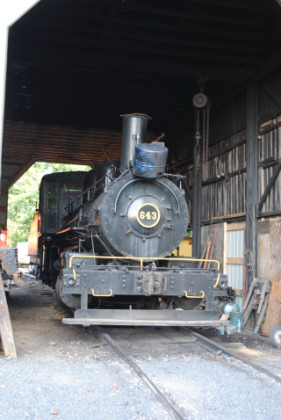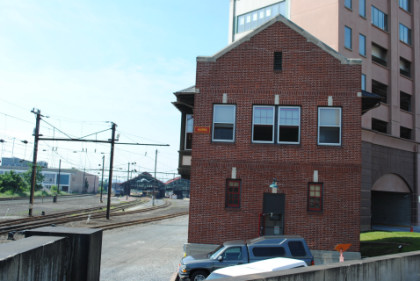

I awoke up the Comfort Inn in Bethel and after uploading the last five stories onto my webpage, walked out to my rental car to drive to Williams Grove. I returned to Interstate 78, taking that to Interstate 81, which took me through Harrisburg. As I crossed the Susquehanna River I saw a train and pulled off.
A Norfolk Southern freight train crossing the Susquehanna River bridge. From there I took US 17 south to Mechanicsburg and road out to Williams Grove.
Williams Grove Historical Steam Engine Association 6/20/2010
I arrived at their parking lot, finding a large crowd for a model railroad swap meet, parked and made my way to the engine house.
A Brief HistoryIt was the Winter of 1958-59 when a group of people met to discuss forming a steam association. The basis of this idea came from their memories of using old-time farm machinery. They formed the Williams Grove Steam Engine Association with their purpose of preserving steam-powered equipment and to educate the public about the history of farming. The association uses steam engines for plowing, harvesting and sawing. It also has early gas engines and tractors plus a Pennsylvania Railroad steam engine. In 1959, Roy Richwine, Sr., owner of the 91 acres Williams Grove Amusement Park, invited the association to use his land which they then purchased.
Pennsylvania Railroad 0-6-0 643 built by the railroad in 1901. By 1917, it was declared surplus and put up for sale. Central Iron and Steel Company of Harrisburg purchased the locomotive and worked for the next forty years, being re-numbered 5. The steel mill closed in 1959 and the engine sat until purchased by the Williams Grove group in 1961.
643 is the only operating Pennsylvania Railroad steam engine in the world.
The steam engine's tender.
A line of their railroad equipment.
Pennsylvania Railroad caboose 980994 built by the railroad in 1916.
Pennsylvania Railroad caboose 477130 built by the railroad in 1917. It was last used by the East Penn Scenic Railroad for excursions out of Topton, Pennsylvania.
Williams Grove Steam Engine Association wooden box car 727, nee Maryland and Pennsylvania 727 built by Baltimore Steel in 1906.
Williams Grove Steam Engine Assocication crane 1 built by Ohio Locomotive Crane Company.
View of the engine house.
Various railroad signs on display.
A station building.
View along their railroad.
Williams Grove Steam Engine Association 25DM switcher 8, nee Pennsylvania Power and Light E129 built by the Whitcomb Locomotive Company in 1953 and was among the last locomotives built under the Whitcomb name. It was purchased by the group in the 1980's and re-numbered to 8. It is used mainly for switching and track work, but does see limited use in passenger service. From 2001-2006, 8 was our primary locomotive while our steam locomotive 643 was out of service.
Williams Grove Steam Engine Association open car 102 built from a Baltimore and Ohio flat car.
Williams Grove Steam Engine Association open car 101 built from a Baltimore and Ohio flat car.
Flat car.
Williams Grove Steam Engine Association tank car 8177, nee Exxon Mobil Corporation 8177.
Track work is an ongoing project. I thanked the crew for having me here this morning and I returned to downtown Harrisburg and parked near my next stop.
Harris Tower, Harrisburg 6/20/2010
Located in downtown Harrisburg at the corner of 7th and Walnut Street, just west of the Amtrak station, is Harris Tower, constructed by the Pennsylvania Railroad in 1929 and opened on April 26, 1930. Its 113 interlocking levers originally controlled the complex maze of switches and signals along 3,250 feet of track between Herr Street and the middle of the Harrisburg passenger station platforms. The tower was later operated by Penn Central (1968-1971) and Amtrak (1971-1992) as the ownership of the terminal and passenger operations changed over the years. As the amount of track in Harrisburg was reduced and regional control operations were computerized and centralized, Harris Tower's importance was diminished and the tower was ultimately closed on November 15, 1991.
On July 24, 1992, Harris Tower was purchased by the Harrisburg Chapter, National Railway Historical Society to be preserved as a publicly accessible museum. Through the Chapter's efforts, the building was listed on the National Register of Historic Places on August 30, 1994. Today, a complex computer program, designed specifically for use at Harris Tower, teaches visitors about the operations of the tower in its heyday. The program is connected to the original 113 interlocking levers, allowing visitors to control virtual trains through a simulation of the 1940's track pattern based on period-correct Pennsylvania Railroad timetables and train schedules. It was opened to the public on June 7th, 2008 as an interactive museum.
I walked up the stairs inside the tower.
This is your first view as you reach the top floor.
Display case.
The model board which contains more than 450 indicator lamps.
The Tower's interlocking achine which has 113 levers.
The Tower Operator's Desk.
Views from Harris Tower.
A signal display.
Telephone boxes.
Display cases.
ATCS monitors. I thanked them for having me when they were not open and returned to the car then drove east out of Harrisburg on Pennsylvania 283, which I took out to Middletown and my first train ride of the day.
| RETURN TO THE MAIN PAGE |